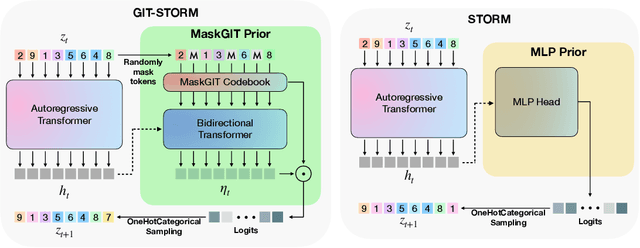Zarif Ikram
Masked Generative Priors Improve World Models Sequence Modelling Capabilities
Oct 10, 2024



Abstract:Deep Reinforcement Learning (RL) has become the leading approach for creating artificial agents in complex environments. Model-based approaches, which are RL methods with world models that predict environment dynamics, are among the most promising directions for improving data efficiency, forming a critical step toward bridging the gap between research and real-world deployment. In particular, world models enhance sample efficiency by learning in imagination, which involves training a generative sequence model of the environment in a self-supervised manner. Recently, Masked Generative Modelling has emerged as a more efficient and superior inductive bias for modelling and generating token sequences. Building on the Efficient Stochastic Transformer-based World Models (STORM) architecture, we replace the traditional MLP prior with a Masked Generative Prior (e.g., MaskGIT Prior) and introduce GIT-STORM. We evaluate our model on two downstream tasks: reinforcement learning and video prediction. GIT-STORM demonstrates substantial performance gains in RL tasks on the Atari 100k benchmark. Moreover, we apply Transformer-based World Models to continuous action environments for the first time, addressing a significant gap in prior research. To achieve this, we employ a state mixer function that integrates latent state representations with actions, enabling our model to handle continuous control tasks. We validate this approach through qualitative and quantitative analyses on the DeepMind Control Suite, showcasing the effectiveness of Transformer-based World Models in this new domain. Our results highlight the versatility and efficacy of the MaskGIT dynamics prior, paving the way for more accurate world models and effective RL policies.
Evolution Guided Generative Flow Networks
Feb 03, 2024Abstract:Generative Flow Networks (GFlowNets) are a family of probabilistic generative models that learn to sample compositional objects proportional to their rewards. One big challenge of GFlowNets is training them effectively when dealing with long time horizons and sparse rewards. To address this, we propose Evolution guided generative flow networks (EGFN), a simple but powerful augmentation to the GFlowNets training using Evolutionary algorithms (EA). Our method can work on top of any GFlowNets training objective, by training a set of agent parameters using EA, storing the resulting trajectories in the prioritized replay buffer, and training the GFlowNets agent using the stored trajectories. We present a thorough investigation over a wide range of toy and real-world benchmark tasks showing the effectiveness of our method in handling long trajectories and sparse rewards.
Probabilistic Generative Modeling for Procedural Roundabout Generation for Developing Countries
Oct 05, 2023Abstract:Due to limited resources and fast economic growth, designing optimal transportation road networks with traffic simulation and validation in a cost-effective manner is vital for developing countries, where extensive manual testing is expensive and often infeasible. Current rule-based road design generators lack diversity, a key feature for design robustness. Generative Flow Networks (GFlowNets) learn stochastic policies to sample from an unnormalized reward distribution, thus generating high-quality solutions while preserving their diversity. In this work, we formulate the problem of linking incident roads to the circular junction of a roundabout by a Markov decision process, and we leverage GFlowNets as the Junction-Art road generator. We compare our method with related methods and our empirical results show that our method achieves better diversity while preserving a high validity score.
Procedural Generation of Complex Roundabouts for Autonomous Vehicle Testing
Mar 31, 2023Abstract:High-definition roads are an essential component of realistic driving scenario simulation for autonomous vehicle testing. Roundabouts are one of the key road segments that have not been thoroughly investigated. Based on the geometric constraints of the nearby road structure, this work presents a novel method for procedurally building roundabouts. The suggested method can result in roundabout lanes that are not perfectly circular and resemble real-world roundabouts by allowing approaching roadways to be connected to a roundabout at any angle. One can easily incorporate the roundabout in their HD road generation process or use the standalone roundabouts in scenario-based testing of autonomous driving.
 Add to Chrome
Add to Chrome Add to Firefox
Add to Firefox Add to Edge
Add to Edge